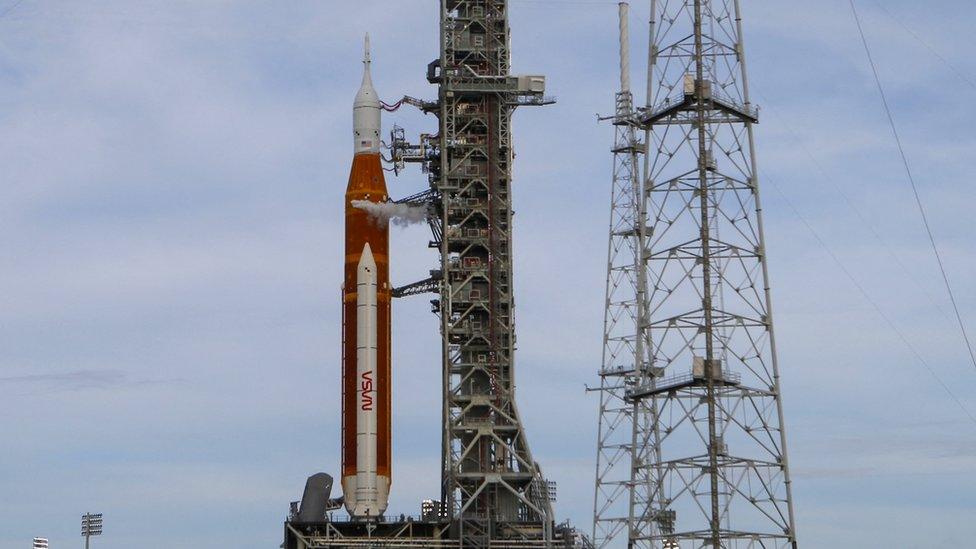Artemis: Nasa cancels Moon rocket launch because of engine problem
- Published
- comments

The test flight of Nasa's Moon rocket - the most powerful ever built - has been delayed.
Engineers were working on a number of problems ahead of Monday's planned launch, including concerns over whether the rocket had a crack in it and worries that there could also be a fuel leak.
But it was one of the engines on the huge rocket that wouldn't cool down to the correct temperature that eventually halted blast-off at the Kennedy Space Center in Florida.
The rocket, known as the Space Launch System (SLS), is the biggest rocket ever developed by Nasa. It will be used to send astronauts back to the Moon.
The first flight, part of Nasa's Artemis programme, is just a demonstration with no-one on board.
Why was the rocket launch cancelled?
Thousands of people had gathered to watch the launch
Nasa officially "scrubbed" the launch with 40 minutes to go until lift-off.
"Scrubbing" is when the team managing the rocket launch calls off the attempted launch on a specific day.
In other words, it's delayed until further notice despite years of preparation and planning.
The scrub will have disappointed the hundreds of thousands of people who had gathered on local beaches to watch the rocket soar into the sky.
The massive Moon rocket, known as the Space Launch System, is two metres taller than London's Big Ben.
The SLS is the most powerful launch rocket since the Saturn V - the rocket for the Apollo Moon missions in the 1960s and 70s.
As part of this mission, SLS will launch an uncrewed capsule called Orion into orbit around the Moon.
Nasa Administrator Bill Nelson, himself a one-time astronaut, said the cautious approach was the right one.
"We don't launch until it's right," he stressed. "And I think it's just illustrative that this is a very complicated machine, a very complicated system. And all those things have to work. You don't want to light the candle until it's ready to go."
Nasa has the option to try again on Friday, if the engine issue can be fixed by then.
However, if controllers have to take the rocket back to Kennedy space centre's assembly building to swap out the engine, it could delay the next launch by several weeks.
All aboard!
One of the important passengers is a dummy! This space mannequin, named Commander Moonikin Campos by the public, will sit in the craft like a human astronaut would
When blast-off eventually happens, there won't be any people onboard, but the capsule won't be empty... passengers and items being sent on the mission to orbit the Moon include Girl Scout badges, Lego figures, tree seeds, a Snoopy plush toy and Shaun the Sheep!
Nasa uses stuffed toys on flights because when they start to float, it indicates that the craft has entered space's zero gravity. Since the toys are soft and light, they won't break any equipment or accidentally press a button, either.
There's also a dummy in one of the astronaut seats... no, we're not being rude! A space mannequin, named Commander Moonikin Campos, will sit in the craft like a human astronaut would.
The mannequin is named after Arturo Campus, an engineer who helped bring the crew of the damaged Apollo 13 safely back to Earth.
Inspiring a new generation
The ±«Óătv's science editor Rebecca Morelle has been following the launch in Florida, she says that the mission hopes to inspire a generation of future space travellers, just as earlier Moon missions inspired children in the 1960s.
"The new missions will be different. Nasa is planning to land the first woman and first person of colour on the Moon - showing that space exploration is open to everyone. And the lunar surface is just the start. Nasa's ambition lies even further afield, its sights are set on Mars. And that truly will be a giant leap to experience."
This flight is a big moment not just for Nasa, but for the European Space Agency too.
It has provided the service module for Orion. This is the rear section that pushes the capsule on its journey through space and on future missions, will guide Orion to the Moon.
Future missions to Mars
This first Artemis mission - with no crew - will last for 42 days and Nasa intends to test the Orion capsule by pushing it beyond the limits that will be in place when there are astronauts on board.
If everything goes smoothly, Artemis II will follow a similar mission plan but this time crewed with astronauts. These astronauts will travel the furthest from the Earth that humans have ever been.
And missions through to Artemis IX (nine) are already being planned.
By that stage there should be a base of sorts on the lunar surface as well as vehicles on the Moon for astronauts to use and plans for the first-ever space station orbiting the Moon, known as the Gateway.
Ultimately, Artemis is seen as a stepping stone to get people to Mars, and in the future, the Moon could be used as a refuelling station before craft blast off further into the solar system.
